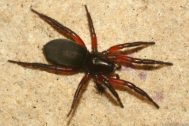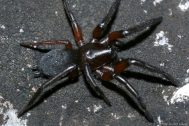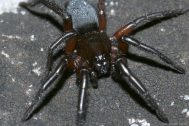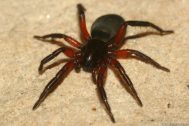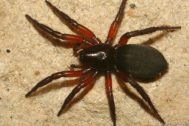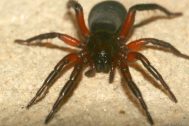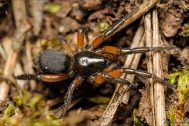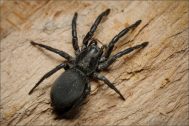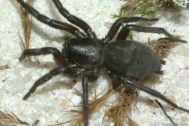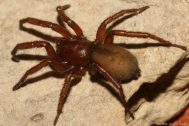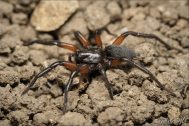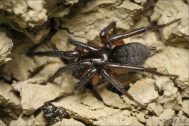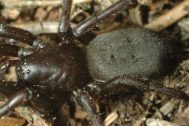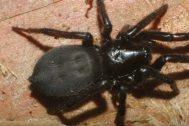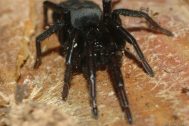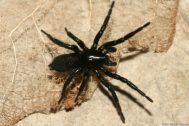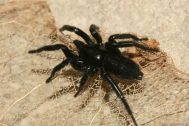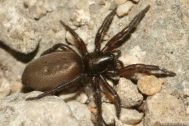| Records by time | |||||
|---|---|---|---|---|---|
| Gnaphosidae | 0-1900 | 1901-1950 | 1951-2000 | 2001+ | ∑ |
 Gnaphosa badia
(L. Koch, 1866) Strongly endangered Gnaphosa badia
(L. Koch, 1866) Strongly endangered |
16× | 16× | |||
 Gnaphosa bicolor
(Hahn, 1833) Endangered Gnaphosa bicolor
(Hahn, 1833) Endangered |
1× | 2× | 111× | 21× | 135× |
 Gnaphosa inconspecta
Simon, 1878 Criticaly endangered Gnaphosa inconspecta
Simon, 1878 Criticaly endangered |
1× | 1× | 2× | ||
 Gnaphosa lapponum
(L. Koch, 1866) Endangered Gnaphosa lapponum
(L. Koch, 1866) Endangered |
34× | 34× | |||
 Gnaphosa lucifuga
(Walckenaer, 1802) Almost threatened Gnaphosa lucifuga
(Walckenaer, 1802) Almost threatened |
5× | 13× | 115× | 74× | 207× |
 Gnaphosa lugubris
(C. L. Koch, 1839) Almost threatened Gnaphosa lugubris
(C. L. Koch, 1839) Almost threatened |
3× | 5× | 108× | 64× | 180× |
 Gnaphosa microps
Holm, 1939 Strongly endangered Gnaphosa microps
Holm, 1939 Strongly endangered |
17× | 1× | 18× | ||
 Gnaphosa modestior
Kulczyński, 1897 Criticaly endangered Gnaphosa modestior
Kulczyński, 1897 Criticaly endangered |
8× | 8× | |||
 Gnaphosa montana
(L. Koch, 1866) Endangered Gnaphosa montana
(L. Koch, 1866) Endangered |
1× | 49× | 22× | 72× | |
 Gnaphosa nigerrima
L. Koch, 1877 Strongly endangered Gnaphosa nigerrima
L. Koch, 1877 Strongly endangered |
2× | 29× | 2× | 33× | |
 Gnaphosa opaca
Herman, 1879 Endangered Gnaphosa opaca
Herman, 1879 Endangered |
1× | 3× | 107× | 60× | 171× |
Bibliography
Pavouci Národního parku a Chráněné krajinné oblasti Šumava
This work summarises data on the spider fauna (Araneae) of the Šumava Mts. (Bohemian Forest, Böhmerwald) National Park and Protected Landscape Area (southwest Bohemia), in the period 1858–2023. We abstracted data from all available literature and our own research initiated in 1971. In our own research, we focused on all available habitats, both natural ones and those influenced by humans. These included namely peat bogs, mountains forest, mountain meadows, wetlands, riverbanks and buildings. Altogether, we identified a total of 455 spider species, many of which belong among rare and endangered in the Czech Republic. Overview of their ecological preferences and importance for nature conservation are provided. Within the Czech Republic, nine species are found only in Šumava: Carorita limnaea, Centromerus dilutus, Dictyna major, Gnaphosa badia, Gnaphosa microps, Micaria aenea, Pardosa ferruginea, Pardosa hyperborea and Cybaeus tetricus. The last mentioned species is the first record for the Czech Republic.
Výsledky faunistického průzkumu pavouků a sekáčů na vybraných lokalitách na území NP Podyjí v roce 2020
Arachnofauna kaolinových oprámů u Horní Břízy
Tato práce se věnuje arachnofauně kaolinových oprámů, kde v minulosti probíhala těžba kaolinu. Po ukončení těžebních pracích byl ve zmíněných jámách ukládán odpad z nedaleké továrny. Tyto antropogenní činnosti samozřejmě výrazně ovlivnily dnešní podobu tohoto území. Navzdory chemickému zatížení nabízí tento biotop vhodné životní podmínky pro bezobratlé živočichy. Sběr pavouků se uskutečnil za použití zemních pastí a byl doplněn individuálním sběrem. Inventarizační výzkum probíhal ve dvou sezónách, od 26. 4 2019 do 19.10 2019 a od 19.3. 2020 do 16.10. 2020. Sledované území bylo rozděleno na těsné (12 stanovišť) a širší (12 stanovišť) okolí 4 oprámů. Druhů bylo zaznamenáno celkem 148 a to ve 25 čeledích. Mezi významné nálezy spadající do kategorie VU (ohrožený) patří pavučenka Silometopus elegans, skálovka Gnaphosa lugubris, slíďáci Pardosa paludicola, Piratula knorri a Hygrolycosa rubrofasciata. Do kategorie EN (silně ohrožené) je zařazena plachetnatka Bathyphantes setiger, slíďák Alopecosa schmidti a skálovka Micaria dives.Výsledky faunistického průzkumu pavouků a sekáčů na vybraných lokalitách na území NP Podyjí v roce 2019
A total of 114 spider species from 25 families and one harvestmen species were found during the zoological research at several sites in the Podyjí National Park during 2019. Of them, forty-one species are listed in the Red List of spiders of the Czech Republic. Four new species for the Podyjí NP were recorded – Callilepis nocturna (Linnaeus, 1758), Euryopis laeta (Westring, 1861), Phrurolithus minimus C. L. Koch, 1839 and Trichoncus auritus (L. Koch, 1869). Among the most interesting species, four critically endangered spiders – Civizelotes caucasius (L. Koch, 1866), Phrurolithus szilyi Herman, 1879, Gnaphosa modestior Kulczyński, 1897 and Eresus moravicus Řezáč, 2008 should be mentioned. Other rare species include Acartauchenius scurrilis (O. Pickard-Cambridge, 1873), Agyneta fuscipalpa (C. L. Koch, 1836), Arctosa figurata (Simon, 1876), Atypus affinis Eichwald, 1830, Bassaniodes robustus (Hahn, 1832), Callilepis schuszteri (Herman, 1879), Centromerus incilium (L. Koch, 1881), Centromerus leruthi Fage, 1933, Cheiracanthium effossum Herman, 1879, Drassyllus villicus (Thorell, 1875), Euryopis quinqueguttata Thorell, 1875, Frontinellina frutetorum (C. L. Koch, 1835), Gibbaranea gibbosa (Walckenaer, 1802), Gnaphosa opaca Herman, 1879, Haplodrassus cognatus (Westring, 1861), Haplodrassus dalmatensis (L. Koch, 1866), Haplodrassus minor (O. Pickard-Cambridge, 1879), Heterotheridion nigrovariegatum (Simon, 1873), Kishidaia conspicua (L. Koch, 1866), Leptorchestes berolinensis (C. L. Koch, 1846), Minicia marginella (Wider, 1834), Phrurolithus pullatus Kulczyński, 1897, Trichopterna cito (O. Pickard-Cambridge, 1873), Walckenaeria simplex Chyzer, 1894, Zelotes erebeus (Thorell, 1871) and Zora manicata Simon, 1878.Výsledky faunistického průzkumu pavouků a sekáčů na vybraných lokalitách na území NP Podyjí v roce 2019
A total of 114 spider species from 25 families and one harvestmen species were found during the zoological research at several sites in the Podyjí National Park during 2019. Of them, forty-one species are listed in the Red List of spiders of the Czech Republic. Four new species for the Podyjí NP were recorded – Callilepis nocturna (Linnaeus, 1758), Euryopis laeta (Westring, 1861), Phrurolithus minimus C. L. Koch, 1839 and Trichoncus auritus (L. Koch, 1869). Among the most interesting species, four critically endangered spiders – Civizelotes caucasius (L. Koch, 1866), Phrurolithus szilyi Herman, 1879, Gnaphosa modestior Kulczyński, 1897 and Eresus moravicus Řezáč, 2008 should be mentioned. Other rare species include Acartauchenius scurrilis (O. Pickard-Cambridge, 1873), Agyneta fuscipalpa (C. L. Koch, 1836), Arctosa figurata (Simon, 1876), Atypus affinis Eichwald, 1830, Bassaniodes robustus (Hahn, 1832), Callilepis schuszteri (Herman, 1879), Centromerus incilium (L. Koch, 1881), Centromerus leruthi Fage, 1933, Cheiracanthium effossum Herman, 1879, Drassyllus villicus (Thorell, 1875), Euryopis quinqueguttata Thorell, 1875, Frontinellina frutetorum (C. L. Koch, 1835), Gibbaranea gibbosa (Walckenaer, 1802), Gnaphosa opaca Herman, 1879, Haplodrassus cognatus (Westring, 1861), Haplodrassus dalmatensis (L. Koch, 1866), Haplodrassus minor (O. Pickard-Cambridge, 1879), Heterotheridion nigrovariegatum (Simon, 1873), Kishidaia conspicua (L. Koch, 1866), Leptorchestes berolinensis (C. L. Koch, 1846), Minicia marginella (Wider, 1834), Phrurolithus pullatus Kulczyński, 1897, Trichopterna cito (O. Pickard-Cambridge, 1873), Walckenaeria simplex Chyzer, 1894, Zelotes erebeus (Thorell, 1871) and Zora manicata Simon, 1878.Epigeic spiders from oak-hornbeam woodland in the Děvín National Nature Reserve (Czech Republic).
Data on the spider fauna from the forest ecosystems of the Děvín National Nature Reserve (South Moravia, Czech Republic) are presented. The research was carried out on 15 randomly chosen research plots in oak-hornbeam forest stands within different management regimes. Spider sampling was done by pitfall trapping from May to October 2016. Overall, 3683 adult spiders belonging to 22 families, 70 genera and 116 species were collected. The families Linyphiidae, Lycosidae, Gnaphosidae and Thomisidae exhibited high species richness. The most abundant species were Pardosa lugubris (Walckenaer, 1802) and Trochosa terricola Thorell, 1856. Faunistically remarkable species were Atypus piceus (Sulzer, 1776), Drassyllus villicus (Thorell, 1875), Gnaphosa montana (L. Koch, 1866), Panamomops affinis Miller & Kratochvíl, 1939 and Walckenaeria monoceros (Wider, 1834). The record of Gnaphosa montana is one of the first accounts of this psychrophilic spider from European lowlands. Of the identified species, 23 are listed in the Red List of Threatened Species in the Czech Republic (EN – 1 species, VU – 12 species, LC – 10 species).Výsledky faunistického průzkumu pavouků a sekáčů na vybraných lokalitách na území NM Podyjí v roce 2018
A total of 151 spider species from 27 families and 4 harvestman species from 2 families were found during the zoological research of several sites in Podyjí National Park during 2018. Seventeen of the species found are listed in the Red List of Spiders of the Czech Republic. The most interesting species are Alopecosa sulzeri (Pavesi, 1873), Amaurobius jugorum L. Koch, 1868, Araniella inconspicua (Simon, 1874), Callilepis schuszteri (Herman, 1879), Clubiona marmorata L. Koch, 1866, Echemus angustifrons (Westring, 1861), Gnaphosa lugubris (C. L. Koch, 1839), Gnaphosa opaca Herman, 1879, Gongylidiellum murcidum Simon, 1884, Haplodrassus minor (O. P.-Cambridge, 1879), Kishidaia conspicua (L. Koch, 1866), Micaria formicaria (Sundevall, 1831), Pseudeuophrys obsoleta (Simon, 1868), Saaristoa abnormis (Blackwall, 1841), Tmarus piger(Walckenaer, 1802), Xysticus luctator L. Koch, 1870, Zelotes erebeus (Thorell, 1871) and the harvestmen Egaenus convexus (C. L. Koch, 1835).
Výsledky faunistického průzkumu pavouků a sekáčů na vybraných lokalitách na území NM Podyjí v roce 2018
A total of 151 spider species from 27 families and 4 harvestman species from 2 families were found during the zoological research of several sites in Podyjí National Park during 2018. Seventeen of the species found are listed in the Red List of Spiders of the Czech Republic. The most interesting species are Alopecosa sulzeri (Pavesi, 1873), Amaurobius jugorum L. Koch, 1868, Araniella inconspicua (Simon, 1874), Callilepis schuszteri (Herman, 1879), Clubiona marmorata L. Koch, 1866, Echemus angustifrons (Westring, 1861), Gnaphosa lugubris (C. L. Koch, 1839), Gnaphosa opaca Herman, 1879, Gongylidiellum murcidum Simon, 1884, Haplodrassus minor (O. P.-Cambridge, 1879), Kishidaia conspicua (L. Koch, 1866), Micaria formicaria (Sundevall, 1831), Pseudeuophrys obsoleta (Simon, 1868), Saaristoa abnormis (Blackwall, 1841), Tmarus piger(Walckenaer, 1802), Xysticus luctator L. Koch, 1870, Zelotes erebeus (Thorell, 1871) and the harvestmen Egaenus convexus (C. L. Koch, 1835).
European species of the Gnaphosa alpica complex (Araneae, Gnaphosidae).
Members of the genus Gnaphosa belong to the largest gnaphosid spiders. They are particularly interesting in nature conservation as their distribution is mainly restricted to disappearing natural non-forest habitats. In Europe, several Gnaphosa species groups occur. The exclusively Palaearctic group G. bicolor is characterised by a retrolaterally-shifted embolus, which occupies at least part of the middle one-third of the palpal bulb; females have laterally expanded epigyne and often have very elongated median epigynal ducts (Ovtsharenko et al. 1992). So far four species of this group have been identified in Europe, with a fifth species found in Central Asia (G. tarabaevi Ovtsharenko, Platnick & Song, 1992). Two of the European species, G. bicolor (Hahn, 1831) and G. badia (L. Koch, 1866), are well known and their taxonomy and nomenclature is stable, but the same does not hold true for the other two.
The taxonomy and nomenclature of the rare European gnaphosid spiders Gnaphosa alpica and Gnaphosa modestior have been confused. Simon (1878) first described females of G. alpica from southwestern Alps. Almost twenty years later, Władysław Kulczyński described two more species, Gnaphosa modestior (single male from northeastern Croatia, and females from central Hungary and southwestern Romania) and G. laeta (single female from northeastern Hungary) (Chyzer & Kulczyński 1897), however the author expressed doubts about the species status of G. laeta and suggested that it may be an abberant female Gnaphosa modestior. Ovtsharenko et al. (1992) later published a review of the north Asian Gnaphosa, including the species from Europe, in which they come to incorrect conclusions regarding the identities of the three aforementioned species/names due to a lack of available material. Recently, we were given the opportunity to review this group of species through the study of new material. We redescribe Gnaphosa modestior and G. alpica (including designation of the lectotype and first description of a male) and describe a new, closely related species G. dolanskyi sp. n. from the southeastern Europe and adjacent regions of Asia. Further, we remove G. laeta from synonymy of G. alpica and suggest it to be a synonym of Gnaphosa modestior.Pavouci (Araneae) a střevlíkovití brouci (Coleoptera, Carabidae) vybraných vřesovišť v západních Čechách.
Results of the exploration of the araneofauna and the entomofauna in West Bohemian heathlands are presented. Spiders and carabid beetles were collected during the vegetation seasons in 2011 and 2012 by the method of pitfall trapping. In total, 3188 specimens of 171 Araneae species and 2168 specimens of 93 Carabid species were determined. The most frequent spiders were Xerolycosa nemoralis (Westring, 1861), a common forest species. The following identified species are listed among the endangered spiders in the Czech Republic in the category „endangered“: Alopecosa schmidti (Hahn, 1835), Micaria dives (Lucas, 1846), Peponocranium orbiculatum (O. P.-Cambridge, 1882), in the category „vulnerable“: Centromerus incilium (L. Koch, 1881), Evansia merens O. P.-Cambridge, 1900, Metopobactrus prominulus (O. P.-Cambridge, 1872), Arctosa figurata (Simon, 1876), Arctosa lutetiana (Simon, 1876), Pardosa nigriceps (Thorell, 1872), Gnaphosa bicolor (Hahn, 1833), Xysticus striatipes L. Koch, 1870, Evarcha laetabunda (C. L. Koch, 1846) and Trichopterna cito (Blackwall, 1841). The most remarkable species of the Carabids were the Amara equestris equestris (Duftschmid, 1812), Amara pulpani Kult, 1949, Bradycellus ruficollis (Stephens, 1828), Carabus arcensis arcensis Herbst, 1784, Carabus problematicus harcyniae Sturm, 1815, Cymindis axillaris axillaris (Fabricius, 1794), Cymindis vaporariorum (Linné, 1758), Masoreus wetterhallii wetterhallii (Gyllenhal, 1813), Olisthopus rotundatus rotundatus (Paykull, 1790). Studied material was reposited at the Department of Zoology of the West Bohemian Museum in Pilsen.
Pavouk 38 (7/2015)
Méně známé druhy pavouků – Frontinellina frutetorum; Pirata von Noldenteich; Křižák Neoscona adianta za humny!; Ještě Porrhomma; Jak je to s původem křižáka Argiope bruennichi v Česku?; Rytířský souboj; Arachnologická exkurze – jižní Morava 2015; Ocenění arachnologové; Aktualizace rolí v České arachnologické společnosti; Konference; Česká bibliografie; Britská bibliografie; Inventarizace 2014Gallery
Gnaphosa bicolor
Gnaphosa lucifuga
Gnaphosa lugubris
Gnaphosa modestior
Gnaphosa montana
Gnaphosa nigerrima
Gnaphosa opaca
Statistics
By month
By altitude
By collecting method (876 used records)
| Zemní past | Males | Females | Juveniles | Records |
|---|---|---|---|---|
| Gnaphosa badia (L. Koch, 1866) | 92 | 20 | 0 | 10 |
| Gnaphosa bicolor (Hahn, 1833) | 172 | 74 | 4 | 95 |
| Gnaphosa lapponum (L. Koch, 1866) | 159 | 7 | 3 | 34 |
| Gnaphosa lucifuga (Walckenaer, 1802) | 131 | 62 | 5 | 67 |
| Gnaphosa lugubris (C. L. Koch, 1839) | 225 | 131 | 14 | 120 |
| Gnaphosa microps Holm, 1939 | 419 | 83 | 0 | 10 |
| Gnaphosa modestior Kulczyński, 1897 | 21 | 6 | 0 | 7 |
| Gnaphosa montana (L. Koch, 1866) | 44 | 15 | 9 | 49 |
| Gnaphosa nigerrima L. Koch, 1877 | 14 | 16 | 0 | 17 |
| Gnaphosa opaca Herman, 1879 | 225 | 133 | 37 | 72 |
| Neurčeno | Males | Females | Juveniles | Records |
| Gnaphosa badia (L. Koch, 1866) | 2 | 2 | 0 | 3 |
| Gnaphosa bicolor (Hahn, 1833) | 6 | 1 | 2 | 22 |
| Gnaphosa inconspecta Simon, 1878 | 0 | 0 | 0 | 2 |
| Gnaphosa lucifuga (Walckenaer, 1802) | 66 | 68 | 2 | 111 |
| Gnaphosa lugubris (C. L. Koch, 1839) | 20 | 18 | 5 | 43 |
| Gnaphosa microps Holm, 1939 | 28 | 4 | 0 | 1 |
| Gnaphosa montana (L. Koch, 1866) | 1 | 4 | 0 | 12 |
| Gnaphosa nigerrima L. Koch, 1877 | 1 | 6 | 0 | 7 |
| Gnaphosa opaca Herman, 1879 | 139 | 144 | 9 | 81 |
| Individuální sběr | Males | Females | Juveniles | Records |
| Gnaphosa badia (L. Koch, 1866) | 1 | 3 | 0 | 3 |
| Gnaphosa bicolor (Hahn, 1833) | 4 | 8 | 1 | 11 |
| Gnaphosa lucifuga (Walckenaer, 1802) | 13 | 22 | 6 | 27 |
| Gnaphosa lugubris (C. L. Koch, 1839) | 7 | 11 | 0 | 14 |
| Gnaphosa microps Holm, 1939 | 2 | 7 | 0 | 3 |
| Gnaphosa modestior Kulczyński, 1897 | 0 | 1 | 0 | 1 |
| Gnaphosa montana (L. Koch, 1866) | 2 | 8 | 0 | 10 |
| Gnaphosa nigerrima L. Koch, 1877 | 7 | 3 | 0 | 3 |
| Gnaphosa opaca Herman, 1879 | 7 | 17 | 0 | 16 |
| Smyk | Males | Females | Juveniles | Records |
| Gnaphosa bicolor (Hahn, 1833) | 8 | 2 | 0 | 4 |
| Gnaphosa lucifuga (Walckenaer, 1802) | 17 | 4 | 0 | 1 |
| Gnaphosa lugubris (C. L. Koch, 1839) | 1 | 2 | 0 | 3 |
| Gnaphosa microps Holm, 1939 | 6 | 1 | 0 | 3 |
| Gnaphosa montana (L. Koch, 1866) | 0 | 1 | 0 | 1 |
| Gnaphosa opaca Herman, 1879 | 1 | 2 | 0 | 1 |
| Prosev | Males | Females | Juveniles | Records |
| Gnaphosa bicolor (Hahn, 1833) | 3 | 0 | 3 | 3 |
| Gnaphosa lucifuga (Walckenaer, 1802) | 0 | 1 | 0 | 1 |
| Gnaphosa microps Holm, 1939 | 0 | 1 | 0 | 1 |
| Gnaphosa nigerrima L. Koch, 1877 | 14 | 5 | 0 | 6 |
| Gnaphosa opaca Herman, 1879 | 1 | 0 | 0 | 1 |
| Males | Females | Juveniles | Records |
By biotope (875 used records)
| Neurčeno | Males | Females | Juveniles | Records |
|---|---|---|---|---|
| Gnaphosa bicolor (Hahn, 1833) | 12 | 2 | 1 | 29 |
| Gnaphosa inconspecta Simon, 1878 | 0 | 0 | 0 | 2 |
| Gnaphosa lucifuga (Walckenaer, 1802) | 159 | 112 | 2 | 136 |
| Gnaphosa lugubris (C. L. Koch, 1839) | 130 | 106 | 6 | 83 |
| Gnaphosa modestior Kulczyński, 1897 | 17 | 5 | 0 | 5 |
| Gnaphosa montana (L. Koch, 1866) | 17 | 9 | 0 | 29 |
| Gnaphosa nigerrima L. Koch, 1877 | 3 | 7 | 0 | 7 |
| Gnaphosa opaca Herman, 1879 | 204 | 177 | 9 | 104 |
| Skalní stepi na vápenci | Males | Females | Juveniles | Records |
| Gnaphosa bicolor (Hahn, 1833) | 1 | 0 | 0 | 1 |
| Gnaphosa lucifuga (Walckenaer, 1802) | 13 | 5 | 1 | 17 |
| Gnaphosa lugubris (C. L. Koch, 1839) | 58 | 22 | 13 | 41 |
| Gnaphosa opaca Herman, 1879 | 123 | 82 | 32 | 30 |
| Suché louky | Males | Females | Juveniles | Records |
| Gnaphosa bicolor (Hahn, 1833) | 0 | 1 | 0 | 1 |
| Gnaphosa lucifuga (Walckenaer, 1802) | 26 | 15 | 6 | 24 |
| Gnaphosa lugubris (C. L. Koch, 1839) | 37 | 14 | 0 | 26 |
| Gnaphosa opaca Herman, 1879 | 35 | 28 | 3 | 26 |
| Rašeliniště | Males | Females | Juveniles | Records |
| Gnaphosa badia (L. Koch, 1866) | 92 | 19 | 0 | 9 |
| Gnaphosa lapponum (L. Koch, 1866) | 10 | 0 | 0 | 5 |
| Gnaphosa microps Holm, 1939 | 455 | 95 | 0 | 17 |
| Gnaphosa montana (L. Koch, 1866) | 1 | 2 | 0 | 6 |
| Gnaphosa nigerrima L. Koch, 1877 | 13 | 17 | 0 | 17 |
| alpínské trávníky | Males | Females | Juveniles | Records |
| Gnaphosa lapponum (L. Koch, 1866) | 149 | 7 | 3 | 29 |
| Gnaphosa montana (L. Koch, 1866) | 1 | 0 | 0 | 1 |
| Lesostepní doubravy | Males | Females | Juveniles | Records |
| Gnaphosa bicolor (Hahn, 1833) | 48 | 24 | 0 | 17 |
| Gnaphosa lucifuga (Walckenaer, 1802) | 2 | 0 | 0 | 2 |
| Gnaphosa lugubris (C. L. Koch, 1839) | 6 | 9 | 0 | 9 |
| Suché doubravy | Males | Females | Juveniles | Records |
| Gnaphosa bicolor (Hahn, 1833) | 28 | 13 | 0 | 19 |
| Gnaphosa lucifuga (Walckenaer, 1802) | 7 | 5 | 0 | 2 |
| Gnaphosa lugubris (C. L. Koch, 1839) | 3 | 2 | 0 | 2 |
| Gnaphosa opaca Herman, 1879 | 0 | 1 | 0 | 1 |
| Paseky | Males | Females | Juveniles | Records |
| Gnaphosa bicolor (Hahn, 1833) | 6 | 6 | 0 | 6 |
| Gnaphosa lucifuga (Walckenaer, 1802) | 1 | 0 | 0 | 1 |
| Gnaphosa lugubris (C. L. Koch, 1839) | 2 | 2 | 0 | 2 |
| Gnaphosa montana (L. Koch, 1866) | 8 | 6 | 0 | 9 |
| Acidofilní bory | Males | Females | Juveniles | Records |
| Gnaphosa bicolor (Hahn, 1833) | 33 | 11 | 5 | 15 |
| Gnaphosa lugubris (C. L. Koch, 1839) | 3 | 2 | 0 | 2 |
| Výsadby jehličnanů | Males | Females | Juveniles | Records |
| Gnaphosa bicolor (Hahn, 1833) | 6 | 2 | 0 | 3 |
| Gnaphosa montana (L. Koch, 1866) | 13 | 4 | 9 | 12 |
| Kamenité suti nižších poloh | Males | Females | Juveniles | Records |
| Gnaphosa bicolor (Hahn, 1833) | 21 | 6 | 0 | 8 |
| Gnaphosa lugubris (C. L. Koch, 1839) | 2 | 1 | 0 | 2 |
| Gnaphosa montana (L. Koch, 1866) | 2 | 2 | 0 | 4 |
| Stinné skály nižších poloh | Males | Females | Juveniles | Records |
| Gnaphosa bicolor (Hahn, 1833) | 10 | 2 | 1 | 6 |
| Gnaphosa lucifuga (Walckenaer, 1802) | 0 | 2 | 0 | 2 |
| Gnaphosa lugubris (C. L. Koch, 1839) | 2 | 0 | 0 | 1 |
| Gnaphosa montana (L. Koch, 1866) | 0 | 1 | 0 | 1 |
| Gnaphosa opaca Herman, 1879 | 5 | 1 | 0 | 2 |
| Kamenolomy | Males | Females | Juveniles | Records |
| Gnaphosa lucifuga (Walckenaer, 1802) | 10 | 11 | 1 | 10 |
| Gnaphosa opaca Herman, 1879 | 0 | 1 | 0 | 1 |
| Přirozené lesy | Males | Females | Juveniles | Records |
| Gnaphosa bicolor (Hahn, 1833) | 12 | 5 | 0 | 9 |
| Xerotermní travinobylinná společenstva | Males | Females | Juveniles | Records |
| Gnaphosa lucifuga (Walckenaer, 1802) | 1 | 0 | 0 | 1 |
| Gnaphosa lugubris (C. L. Koch, 1839) | 1 | 2 | 0 | 2 |
| Gnaphosa modestior Kulczyński, 1897 | 1 | 0 | 0 | 1 |
| Gnaphosa opaca Herman, 1879 | 5 | 3 | 2 | 4 |
| Suťové a roklinové lesy | Males | Females | Juveniles | Records |
| Gnaphosa bicolor (Hahn, 1833) | 5 | 1 | 0 | 4 |
| Gnaphosa lugubris (C. L. Koch, 1839) | 3 | 0 | 0 | 1 |
| Gnaphosa montana (L. Koch, 1866) | 0 | 1 | 0 | 1 |
| Skalní stepi na jiných horninách | Males | Females | Juveniles | Records |
| Gnaphosa lucifuga (Walckenaer, 1802) | 4 | 3 | 3 | 4 |
| Gnaphosa opaca Herman, 1879 | 1 | 2 | 0 | 2 |
| Mokré louky | Males | Females | Juveniles | Records |
| Gnaphosa nigerrima L. Koch, 1877 | 6 | 5 | 0 | 6 |
| Reliktní bory na skalách | Males | Females | Juveniles | Records |
| Gnaphosa bicolor (Hahn, 1833) | 1 | 2 | 0 | 3 |
| Gnaphosa lugubris (C. L. Koch, 1839) | 1 | 1 | 0 | 2 |
| Lesní okraje | Males | Females | Juveniles | Records |
| Gnaphosa bicolor (Hahn, 1833) | 0 | 1 | 3 | 3 |
| Gnaphosa lugubris (C. L. Koch, 1839) | 1 | 0 | 0 | 1 |
| Lesy | Males | Females | Juveniles | Records |
| Gnaphosa bicolor (Hahn, 1833) | 1 | 1 | 0 | 2 |
| Gnaphosa montana (L. Koch, 1866) | 1 | 1 | 0 | 2 |
| Lesy | Males | Females | Juveniles | Records |
| Gnaphosa lugubris (C. L. Koch, 1839) | 0 | 0 | 0 | 1 |
| Gnaphosa montana (L. Koch, 1866) | 0 | 1 | 0 | 3 |
| Travnaté stepi | Males | Females | Juveniles | Records |
| Gnaphosa bicolor (Hahn, 1833) | 0 | 1 | 0 | 1 |
| Gnaphosa lucifuga (Walckenaer, 1802) | 2 | 0 | 0 | 2 |
| Gnaphosa opaca Herman, 1879 | 0 | 1 | 0 | 1 |
| Suché křoviny | Males | Females | Juveniles | Records |
| Gnaphosa bicolor (Hahn, 1833) | 4 | 2 | 0 | 3 |
| Okraje silnic | Males | Females | Juveniles | Records |
| Gnaphosa lucifuga (Walckenaer, 1802) | 0 | 1 | 0 | 1 |
| Gnaphosa lugubris (C. L. Koch, 1839) | 1 | 0 | 0 | 1 |
| Břehy tekoucích vod | Males | Females | Juveniles | Records |
| Gnaphosa badia (L. Koch, 1866) | 0 | 2 | 0 | 2 |
| Luční ostřicové mokřady | Males | Females | Juveniles | Records |
| Gnaphosa microps Holm, 1939 | 0 | 1 | 0 | 1 |
| Gnaphosa nigerrima L. Koch, 1877 | 2 | 0 | 0 | 1 |
| Suché lesní lemy | Males | Females | Juveniles | Records |
| Gnaphosa lugubris (C. L. Koch, 1839) | 2 | 0 | 0 | 2 |
| Dubohabřiny | Males | Females | Juveniles | Records |
| Gnaphosa bicolor (Hahn, 1833) | 2 | 0 | 0 | 1 |
| Gnaphosa montana (L. Koch, 1866) | 2 | 0 | 0 | 1 |
| Skalní a suťové biotopy | Males | Females | Juveniles | Records |
| Gnaphosa badia (L. Koch, 1866) | 2 | 1 | 0 | 2 |
| Louky a pastviny | Males | Females | Juveniles | Records |
| Gnaphosa lucifuga (Walckenaer, 1802) | 1 | 0 | 0 | 1 |
| Gnaphosa lugubris (C. L. Koch, 1839) | 1 | 0 | 0 | 1 |
| Ruderály | Males | Females | Juveniles | Records |
| Gnaphosa lucifuga (Walckenaer, 1802) | 0 | 1 | 0 | 1 |
| Gnaphosa modestior Kulczyński, 1897 | 0 | 1 | 0 | 1 |
| Louky | Males | Females | Juveniles | Records |
| Gnaphosa lucifuga (Walckenaer, 1802) | 0 | 0 | 0 | 1 |
| Gnaphosa montana (L. Koch, 1866) | 0 | 1 | 0 | 1 |
| Výsadby listnáčů | Males | Females | Juveniles | Records |
| Gnaphosa montana (L. Koch, 1866) | 1 | 0 | 0 | 1 |
| Louky | Males | Females | Juveniles | Records |
| Gnaphosa badia (L. Koch, 1866) | 0 | 0 | 0 | 1 |
| Porosty borůvek | Males | Females | Juveniles | Records |
| Gnaphosa nigerrima L. Koch, 1877 | 9 | 0 | 0 | 1 |
| Lužní lesy nížin | Males | Females | Juveniles | Records |
| Gnaphosa nigerrima L. Koch, 1877 | 3 | 1 | 0 | 1 |
| Bučiny nižších poloh | Males | Females | Juveniles | Records |
| Gnaphosa montana (L. Koch, 1866) | 1 | 0 | 0 | 1 |
| Nehluboké podzemní prostory (pukliny, půdní horizonty) | Males | Females | Juveniles | Records |
| Gnaphosa lugubris (C. L. Koch, 1839) | 0 | 1 | 0 | 1 |
| Horské smrčiny | Males | Females | Juveniles | Records |
| Gnaphosa badia (L. Koch, 1866) | 1 | 1 | 0 | 1 |
| Osluněné skály nižších poloh | Males | Females | Juveniles | Records |
| Gnaphosa lucifuga (Walckenaer, 1802) | 0 | 2 | 0 | 1 |
| Mezofilní louky | Males | Females | Juveniles | Records |
| Gnaphosa bicolor (Hahn, 1833) | 1 | 1 | 0 | 1 |
| Těžebny písku a jiných nezpevněných hornin | Males | Females | Juveniles | Records |
| Gnaphosa bicolor (Hahn, 1833) | 1 | 2 | 0 | 1 |
| Skály a sutě v horách | Males | Females | Juveniles | Records |
| Gnaphosa bicolor (Hahn, 1833) | 0 | 1 | 0 | 1 |
| Kukuřičná pole | Males | Females | Juveniles | Records |
| Gnaphosa bicolor (Hahn, 1833) | 1 | 1 | 0 | 1 |
| Vřesoviště nižších poloh | Males | Females | Juveniles | Records |
| Gnaphosa lucifuga (Walckenaer, 1802) | 1 | 0 | 0 | 1 |
| Lesy vyšších poloh a strmých svahů | Males | Females | Juveniles | Records |
| Gnaphosa badia (L. Koch, 1866) | 0 | 2 | 0 | 1 |
| Males | Females | Juveniles | Records |












